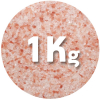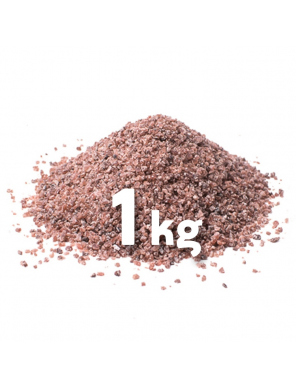Products
- Ayurvedic tea
- Indian teas
- Supplements
- Oils and drinks for health
- Facial Care
- For Skin
- Dental care
- For personal hygiene
- Sport and Yoga
- For Hair Health
- For massage
- Healthcare
- For Women
- Supplements for Men
- Aromatherapy Essential Oil
- Incense sticks
- Indian Food
- Vegan
- Superfoods
- For meditation
- For home
- New Products
- Specials
- Ayurvedic Herbs
- Wholesale
- Gifts and Kits
Browser notifications:
BLACK HIMALAYAN SALT Kala Namak 1kg
Black volcanic salt Kala Namak, FINE
Сountry of origin: Pakistan
Net weight: 1kg
Indian black salt, also known as kala namak or sanchal, is a type of Indian volcanic rock salt commonly used in India, Pakistan and other Asian countries. The “black” salt is actually pinkish-grey due to the presence of iron and other minerals. Indian black salt has a very distinctive sulfurous taste, often compared to hard-boiled egg yolks. Its health benefits are numerous according to ayurvedic medicine.Indian black salt has been used as a condiment for many hundreds of years in Asian countries surrounding the Himalayan mountains. It was originally obtained from either natural volcanic mines in Northern India and Pakistan or the surrounding salt lakes of Sambhar or Didwana. Traditionally, the salt was processed with heat, charcoal and plant material, which yielded a dark crystal rich in sulfide compounds. The traditionally made salt is also high in iron and many other minerals.
Composition
Indian black salt consists primarily of sodium chloride, which is the main component of table salt, and trace impurities that include sulfates, sulfides, iron and magnesium. The sodium chloride provides the salty taste, the iron sulfide provides its pinkish-grey color and the hydrogen sulfide provides its distinctive smell. Hydrogen sulfide is also one of the causes of rotten egg odor, although Indian black salt is often said to resemble the smell of boiled egg yolks.
Health Benefits
Indian black salt is considered a cooling spice in ayurvedic medicine and is recommended for many health issues such as constipation, indigestion, heartburn, bloating, flatulence, goiter, poor eyesight and hysteria, according to the book “Herbs that Heal.” In India, black salt is sometimes recommended to people on low-salt diets due to hypertension because it’s believed to be lower in sodium content compared to regular table salt.
Cooking Benefits
Indian black salt is used extensively on Indian food, including chutneys, yogurts, pickles, salads and all kinds of fruits. It’s often appreciated by strict vegans because it mimics the taste of eggs in tofu and other vegetarian dishes. During the hot Indian summer months, it’s also sometimes used to flavor cool drinks, which is a practical way to replace sodium lost through excessive perspiration.
Cooking recipe for Kitchari:
It's very tasty and healthy dish. It has everything you need for the body, while Kitchari minimum flow the rate of the organism in its digestion, which helps to cleanse the body. You can eat only Kitchari all your life and stay healthy!
For 1 serving:
Measure 1 cup of the rice and ½ part of dala. For a large portion is 1/3 of 200g cup of rice. Proportions - accordingly!
Boil a kettle of water.
In a saucepan, where we cook, put 1/2 tsp. of Ghee oil and put on the stove.
When the butter has melted - quickly add the spices. For 30-40sek. spices are added in the following sequence:
First, whole - grain - mustard and cumin - 1/3 tsp.
Then the ground - turmeric, ginger, coriander and asafoetida - 1/4 tbsp.
In the hot oil and spices we add metered rice and dal. All together fry for 1-2 minutes.
Add the boiling water - 4 parts. Measure the same cup or mug!
All the mix. All at once in full swing. Add the methi leaves and salt.
You can add 1 small carrot and a little pumpkin - then Kitchari will be more juicy and tasty.
Immediately do the smallest fire and set the timer for 20 minutes.
After 20 minutes Kitchari is ready. Turn off the fire. Everything is ready!
Add the Ghee butter, greens and black salt.
Bon Appetite!
Сountry of origin: Pakistan
Net weight: 1kg
Indian black salt, also known as kala namak or sanchal, is a type of Indian volcanic rock salt commonly used in India, Pakistan and other Asian countries. The “black” salt is actually pinkish-grey due to the presence of iron and other minerals. Indian black salt has a very distinctive sulfurous taste, often compared to hard-boiled egg yolks. Its health benefits are numerous according to ayurvedic medicine.Indian black salt has been used as a condiment for many hundreds of years in Asian countries surrounding the Himalayan mountains. It was originally obtained from either natural volcanic mines in Northern India and Pakistan or the surrounding salt lakes of Sambhar or Didwana. Traditionally, the salt was processed with heat, charcoal and plant material, which yielded a dark crystal rich in sulfide compounds. The traditionally made salt is also high in iron and many other minerals.
Composition
Indian black salt consists primarily of sodium chloride, which is the main component of table salt, and trace impurities that include sulfates, sulfides, iron and magnesium. The sodium chloride provides the salty taste, the iron sulfide provides its pinkish-grey color and the hydrogen sulfide provides its distinctive smell. Hydrogen sulfide is also one of the causes of rotten egg odor, although Indian black salt is often said to resemble the smell of boiled egg yolks.
Health Benefits
Indian black salt is considered a cooling spice in ayurvedic medicine and is recommended for many health issues such as constipation, indigestion, heartburn, bloating, flatulence, goiter, poor eyesight and hysteria, according to the book “Herbs that Heal.” In India, black salt is sometimes recommended to people on low-salt diets due to hypertension because it’s believed to be lower in sodium content compared to regular table salt.
Cooking Benefits
Indian black salt is used extensively on Indian food, including chutneys, yogurts, pickles, salads and all kinds of fruits. It’s often appreciated by strict vegans because it mimics the taste of eggs in tofu and other vegetarian dishes. During the hot Indian summer months, it’s also sometimes used to flavor cool drinks, which is a practical way to replace sodium lost through excessive perspiration.
Cooking recipe for Kitchari:
It's very tasty and healthy dish. It has everything you need for the body, while Kitchari minimum flow the rate of the organism in its digestion, which helps to cleanse the body. You can eat only Kitchari all your life and stay healthy!
For 1 serving:
Measure 1 cup of the rice and ½ part of dala. For a large portion is 1/3 of 200g cup of rice. Proportions - accordingly!
Boil a kettle of water.
In a saucepan, where we cook, put 1/2 tsp. of Ghee oil and put on the stove.
When the butter has melted - quickly add the spices. For 30-40sek. spices are added in the following sequence:
First, whole - grain - mustard and cumin - 1/3 tsp.
Then the ground - turmeric, ginger, coriander and asafoetida - 1/4 tbsp.
In the hot oil and spices we add metered rice and dal. All together fry for 1-2 minutes.
Add the boiling water - 4 parts. Measure the same cup or mug!
All the mix. All at once in full swing. Add the methi leaves and salt.
You can add 1 small carrot and a little pumpkin - then Kitchari will be more juicy and tasty.
Immediately do the smallest fire and set the timer for 20 minutes.
After 20 minutes Kitchari is ready. Turn off the fire. Everything is ready!
Add the Ghee butter, greens and black salt.
Bon Appetite!
Also bought
 HIMALAYAN SALT coarse 1kg
2.50€
Himalayan pink salt (coarse)
HIMALAYAN SALT coarse 1kg
2.50€
Himalayan pink salt (coarse)
 METHI FENUGREEK POWDER
1.90€
Fenugreek seeds powder
METHI FENUGREEK POWDER
1.90€
Fenugreek seeds powder
Top sellers
 CHIA seeds 500g
5.50€
Chia seeds - a natural source of Omega 3
CHIA seeds 500g
5.50€
Chia seeds - a natural source of Omega 3
 HIMALAYAN SALT fine 1Kg
2.50€
Himalayan pink salt (fine)
HIMALAYAN SALT fine 1Kg
2.50€
Himalayan pink salt (fine)
 CINNAMON POWDER HERBALS 100g
2.50€
Cinnamon for health and slim body
CINNAMON POWDER HERBALS 100g
2.50€
Cinnamon for health and slim body
This item has been added to cart.











